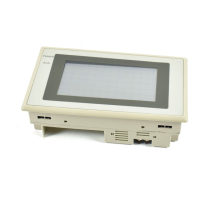36
Connection to a PC by the Host Link
Section 2-4
When Long-Distance Transmission is Required
When transmission over a distance exceeding the RS-232C specification is re-
quired, it can be achieved by using an RS-232C/RS-422A converter unit (type NT-
AL001) to switch to RS-422A communication (RS-485 communication cannot be
used).
For details, refer to “Connecting to an RS-232C/RS-422A Converter Unit (1:1)”
(page 269).
2-4-3 PC Switch Settings
When the NT20S and PC are connected to each other, set the conditions at the PC
host link unit or the CPU as given in the table below.
The following is a general description of switch settings.
Refer to the manual for respective units for the details of the switch settings.
Item Switch Setting
I/O port RS-232C
Baud rate Set the same baud rate as the NT20S. (
1)
Transfer code ASCII 7 data bits, 2 stop bits
Parity Even
1-to-1/1-to-N 1-to-N (
2)
Instruction level Level 1, 2, 3
Unit # 00
Note: 1. Set the host link baud rate at 9600 bps or 19200 bps with the memory switch
for “host link baud rate”. For the details, refer to “Selecting the Host Link Com-
munication Speed” (page 79).
2. The 1-to-N setting enables BCC (Block Check Character).
It is not possible to connect more than one NT20S in a single host link.
When using CVM1/CV series, always set CPU execution processing (execution
control 2) in the PC system settings to simultaneous processing.

